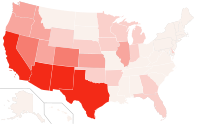
Photo from wikipedia
Type 2 diabetes is increasingly recognized as a spectrum of metabolic disorders sharing chronic hyperglycaemia. In Europe, the continually growing number of migrants from developing countries could affect diabetes phenotypes.… Click to show full abstract
Type 2 diabetes is increasingly recognized as a spectrum of metabolic disorders sharing chronic hyperglycaemia. In Europe, the continually growing number of migrants from developing countries could affect diabetes phenotypes. We evaluated a population of 426 Italians and 412 undocumented migrants. Using 17 variables (with the exclusion of ethnic origin) we performed a multiple component analysis to detect potential clusters, independently from ethnicity. We also compared the two groups to evaluate potential ethnicity associated differences. We found five clusters of patients with different disease phenotypes. Comparing Italians with undocumented migrants, we noted that the first had more often cardiovascular risk factors and neurologic involvement, while the latter had a higher frequency of diabetic ulcers and renal involvement. Metformin was used in a comparable percentage of patients in all clusters, but other antidiabetic treatments showed some differences. Italians were more often on insulin, due to a larger use of long acting insulin, and received a larger number of oral antidiabetics in combination. Pharmacological treatment of comorbidities showed some differences too. We suggest that type 2 diabetes should be considered as a spectrum of diseases with different phenotypes also in heterogeneous populations, and that this is not due only to ethnic differences.
Journal Title: International Journal of Environmental Research and Public Health
Year Published: 2020
Link to full text (if available)
Share on Social Media: Sign Up to like & get
recommendations!